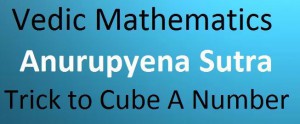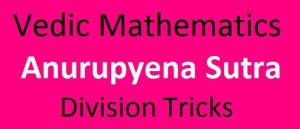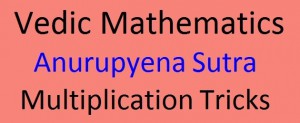As we have seen Vedic Mathematics has various methods to solve the multiplications. But we need to remember 1 thing TIME. Vedic Mathematics can be used very effectively iff you know when and which method/sutra is to be applied. (Post your answers in comment section) What You Think ???? Below are the Vedic Mathematics Multiplication Examples. Using which method or combinations of methods should be applied to multiply numbers & why ?? 1) 113 x 88 2) 1112 x 1003 3) 42 x 98 4) 42 x 55 5) 113 x 117 6) 456 x 543 7) 879 x 287 8) 1131 x 99 9) 829 x 1002 10) 987 x 878 Subscribe us for regular updates … [Read more...]
#@1 How to find cube of a number using Anurupyena in Vedic Mathematics
Anurupyena Sutra Anurupyena means Proportionality Prerequisites: Before starting with shortcut to find cube of a number in Vedic Mathematics below concepts are required. Vinculum Technique. Nikhilam method of Multiplication Nikhilam method of Division No Specific Condition Required Formula: Lets see Vedic Maths tricks for Cube of a 2 digit number using Anurupyena Sutra: Also Check => More Sutras of Vedic Mathematics to calculate cube of a number (a+b)3 = a3 + 3a2b + 3ab2 + b3 Examples: Interesting Fact: 1st row will always be in Geometric Progression. (a3, a2b, ab2, b3) … [Read more...]
How to Divide in 1 line In Vedic mathematics using Ekadhikena Purvena
Ekadhikena Purvena - Divide numbers in one line. Shortcut Division when Divisor Ending with 9 Sutra Used: Ekadhikena Purvena (1 more than the previous)(see more in Squares topic). Examples: 1/19 I: Method 1 (L --> R): For the denominator 19, the purva (previous) is 1. Hence Ekadhikena purva (one more than the previous) is 1 + 1 = 2. Now we will be using 2 for Division purpose. Write 1/19 as 1/20 (but remember they are not equal : )) Steps: Divide 1 by 2 which gives Quotient as 0(written with yellow) and Remainder as 1 (written on left side of Quotient with White) Now divide 10 by 2 which gives Quotient as 5(written with yellow) and Remainder as 0 (written on left side of Quotient with White) Now divide 05 by 2 which gives Quotient as 2(written with yellow) and Remainder as 1 (written on left side of Quotient with White) Similarly go on carrying this process till you find same pair of Quotient and Remainder is obtained. At the end we get 01, on dividing it by 2 we get Quotient as 0 and Remainder as 1. So that means same series (from blue dot to blue dot) will keep on repeating. So the series written in yellow color is final answer. II: Method 2 (R--> L): Here as well Ekadhikena Purvena is 2. BUT here we use 2 for multiplication purpose. Steps: (From R --> L) We start by putting 1. Multiply it 2 which gives 2. Now Multiply 2 by 2 which gives 4. Now Multiply 4 by 2 which gives 8. Now Multiply 8 by 2 which gives 16. Carry forward 1 (written in yellow). Now multipliy 6 by 2 and add the carry forward to it, gives 13. Carry Forward 1. Similarly go on carrying this process till you find same pair of Quotient and Remainder is obtained. Finally 0 will be obtained with carry forward 1. Multiplying 0 with 2 and adding carry forward gives 1 which repeats the series. So the series written in yellow color is final answer. III: Method 3 (More Shorter): Any of the above 2 methods are carried out till a certain criteria … [Read more...]
How to divide in Vedic Mathematics using Anurupyena Sutra & Vinculum
Anurupyena & Vinculum Division using Vedic Mathematics when Nikhilam and Paravartya is not possible to be applied BUT if divisor is either multiplied or divided by some factor then it is possible. Anurupyena Sutra Division As seen earlier in Multiplication, Anurupyena means Proportion. Topics need to be known before starting: In this topic I will let you know the shortcut to divide numbers using Anurupyena Sutra. But before checking Anurupyena Methos below concepts are required. Basic Requisites page. Anurupyena method from Multiplication Nikhilam Method of Division Paravartya Specific Condition Required: As we know the meaning of Anurupyena (as proportion/ratio), we multiply/divide by factor to make divisor closer to larger number (To apply Nikhilam) OR to make closer to smaller number (To apply Paravartya). Later we multiply/divide QUOTIENT with same factor. Also Read => More Division Sutras in Vedic Mathematics Anurupyena Division Tricks: Its always good to use factors for multiplication instead of division because if division is used then on dividing Quotient by that factor might create non-integer i.e. a decimal quotient. To avoid overheads its better to use multiplication. It might follow or followed by Vinculum for simplicity purpose. Vinculum As seen earlier with bigger digits, calculation/process gets little bulky. So using Vinculum we need to convert bigger digits to smaller. Prerequisites: Vinculum and How to Play with Quotients and Remainders. Nikhilam and Paravartya Methods of Division As discussed earlier when we have larger divisor we apply Nikhilam and when we have smaller divisor we apply Paravartya. But when we have 1 or more larger digits (6,7,8,9) in divisor then calculating answer becomes little lengthy/time consuming also big multiplications are to be done. So we can convert such divisors in Vinculum Number. Example: # 2621/828 For already seen this example in … [Read more...]
Anurupyena Sutra – Multiplication in Vedic Mathematics
Anurupyena Sutra Shortcut method of multiplication in Vedic Mathematics (when Nikhilam sutra/method cannot be applied i.e. numbers are not closer to power of 10 but are closer to each other) Sanskrit Name: अनुरुप्येण English Translation: Proportion/Many Forms Meaning Various Forms(Proportion/Ratio). Eg: 2 can be written as 2 OR 4/2 OR 16/8 OR 1*2 OR 0.5*4 , etc. Stuff you need to know before starting: Before starting with Anurupyena multiplication tricks , I recommend you to go through the 2.Vinculum Process and Nikhilam Sutra of Multiplication. This 2 techniques will help you to understand Anurupyena. Specific Condition Required: Anurupyena sutra multiplication is used whenever both numbers are not closer to power of 10(10, 100, 1000, etc) and hence applying Nikhilam Method is not simple. But if numbers are closer to multiples of 10's (i.e. closer to each other) and their difference are easy to multiply then we can apply this Anurupyena Technique. Also Read => More Vedic Mathematics Sutras for Multiplication. Process: Working Base(W.B.) concept: If numbers are closer to 60, we take working base as 60 (10X6) instead of 100. Here factor is 6. If numbers are closer to 50, we can take working base as 50 (10X5) OR 50 (100/2), etc, here factors are 5 and 2 respectively Apply concept of Nikhilam as usual. Mutiply/divide by the SAME factor used in 1st step. i.e. W.B. is obtained by multiplication of factor then Mutiply else divide. Watch below Video on Anurupyena multiplication tips: httpv://youtu.be/ihxCPHo0Y2Q … [Read more...]


